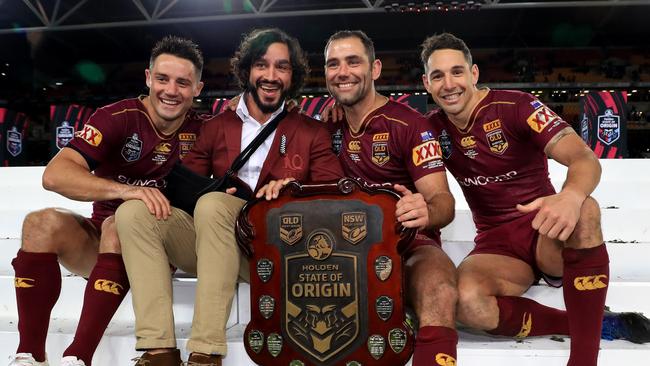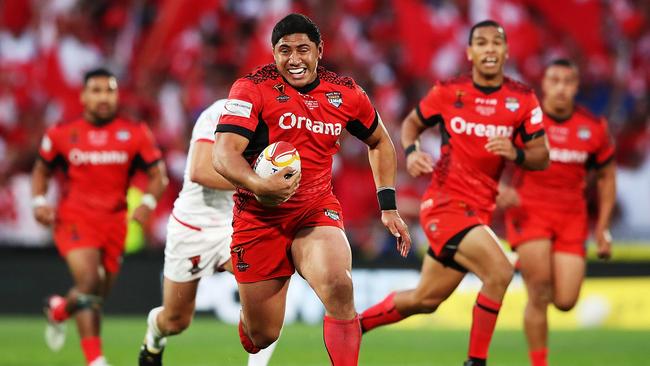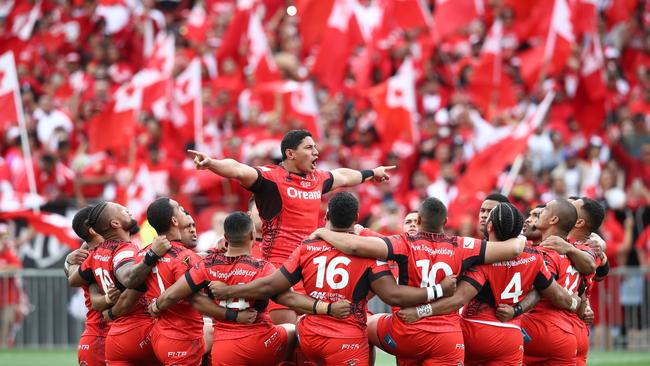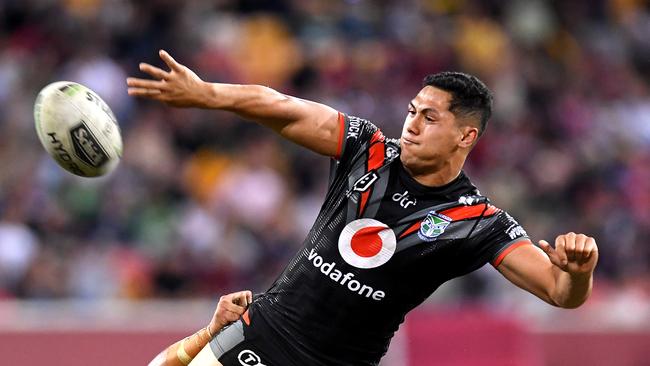Campo’s Corner: The five rugby league legends who take an era with them
Cooper Cronk’s retirement means Cameron Smith will be the final standard-bearer for an entire era of rugby league writes NICK CAMPTON.
BOLTER: Graham on the look for Origin
BLUES: Our experts pick their teams
Some weeks back, after Latrell Mitchell scored 26 points in a match, The Daily Telegraph’s experts were polled as to who was the best player in rugby league right now.
It was an interesting idea because for the first time in a decade there’s something of a vacuum at the top of rugby league, one which is made all the more apparent by Cooper Cronk’s retirement at season’s end.
It means that in the space of 12 months Johnathan Thurston, Billy Slater, Greg Inglis and Cronk will all have hung them up and Cameron Smith, the first and the last, will be the only one left standing.
These five players are the five dominant players of this decade, five of the best ever and all five will enter Immortal conversations.
The surest sign of these five’s greatness is their longevity. From 2005 to 2017 they won nine Dally M medals and between them played 152 Origin matches and 201 Tests.

Origin I this year will be the first match since 2003 without at least one of them taking part.
Australia’s loss to New Zealand at the end of last year was the first time in 60 Tests where one of the five did not pull on the green and gold.
The likes of Jarryd Hayne and Ben Barba had seasons; these five had eras. At least one of them has taken part in 13 of the last 15 grand finals. Cronk alone has played in eight - only Ron Coote and three Dragons from the 11-year run in 1950s and 60s have played in more.
No player in rugby league history has ever been the unquestioned best in his position for as long as Smith, who became the prince of hookers by surpassing Danny Buderus in 2006 and never looked back again.
Since he became a starter in 2006 Cronk has played at least 20 matches in a season 12 out of 13 times. Slater missed almost two full seasons to injury and still managed 319 first grade games. Thurston holds the record for most consecutive Origin matches which may well never be broken. Inglis scored a combined 49 tries in representative matches, the most of any player in the Origin era.
Their longevity has been extraordinary and totally at odds with the history of rugby league. Nobody stays at the top for that long, not without being surpassed. Cronk joining the other three in retirement and the knowledge that nobody, not even Cameron Smith, can play forever, opens the door for a return to regularly scheduled programming where the title of best player in the game is hotly debated, disputed, and changes hands often.

Look at the years before The Five. If we take 2005 as their true launching point into greatness – which seems fair enough given that’s when Thurston won his first Dally M and became the first of the four to catapult to the game’s top echelon – then in 2004 alone we have Darren Lockyer (who moved to five-eighth that season and by the end of the year was the best five-eighth in the world), Danny Buderus (who won the Dally M in his finest ever year) and Brad Fittler (in his final year of first grade but still good enough to lead the Roosters to the minor premiership and the Blues to a series win) all contending for the top prize. Even now there will be no consensus and we’re talking about one season 15 years past.
For over 10 years, one of the five being the best player in the game was an iron truth, inalienable and undeniable. Just take a look at the lists the rest of The Daily Telegraph journos submitted to realise this is no longer so. Thirteen different players were named, including Smith and Cronk. It’s a lively debate, even with Smith still around.
I had Jason Taumalolo first on my list and I stand by that. It’s been a long time since a non-spine player was counted as the best in the game – you might have to go back to Arthur Beetson’s heyday to find the last – but nobody can do what Taumalolo does every week and nobody has done so much but still has so much still in front of him.

He has bent the realms of what is possible for lock forwards, just as Smith did for halves and Slater for fullbacks, and in trading black and white for Tongan red he is building a legacy that can be compared to Dally Messenger. I cannot put anyone above him.
But that’s not a universal opinion. James Tedesco has assumed Slater’s mantle as the game’s best fullback and Roger Tuivasa-Sheck is millimetres behind, Smith is still the king of hookers and Damien Cook the prince, Cameron Munster is the best five-eighth in the game but not by much because Cody Walker is making up for all his lost time and Luke Keary is right there with them.dally
The end of days is upon us, the old gods are all leaving together. There might not have been a consensus on rugby league’s top gun while The Five ruled, but we at least knew who to choose from. But there’s no more dynasty, only a ladder to be climbed and a title to be taken, held and lost.
COULD SAMOA FOLLOW TONGA?
Tevita Pangai Junior’s decision to commit to Tonga over New South Wales this week was a welcome boost for international football, even though Pangai Junior was only an outside chance of being named for his Origin debut. We’re now a full 18 months removed from the 2017 World Cup, when Jason Taumalolo, Andrew Fifita and the rest opened the door for international rugby league to change forever – if Pangai Junior had turned his back on the Tongans it would have been a serious blow to the cause.
As it stands, Tonga boast the best forward pack in the world. Fifita, Sio Suia Taukeiaho, Addin Fonua-Blake, Joe Ofahengaue and Taumalolo are their middles, Pangai Junior, Manu Ma’u and Ben Murdoch-Masila are their edge forwards and Siliva Havili has serious competition in Manase Fainu at hooker.
Tevita Tatola and Moeaki Fotuaika give even more depth and if the Tongans can lure David Fifita across it’ll be another serious coup.

Will Hopoate, the Jennings brothers and David Fusitu’a and Daniel Tupou fill out a backline which is still strong despite Tui Lolohea and Konrad Hurrell heading to Super League and Solomone Kata struggling for form. Without Lolohea the halves will be a problem – Ata Hingano will likely have to partner Fainu, or perhaps even Hopoate, but the framework for a great and lasting team is here. The work is not done but great strides have been made.
The same can’t be said of Samoa, who looked set for a similar surge after their excellent performances at the 2013 World Cup and in the 2014 Four Nations.
They haven’t won a game since 2016, a streak of seven winless outings and now lag well behind the Tongans, Fiji and maybe even Papua New Guinea in the international pecking order.

This can change though, if they have their own Taumalolo moment and they have a ready-made man, born in Apia itself, who can do it.
Roger Tuivasa-Sheck is in the thick of the “best player in the game” conversation we had above. He won the Dally M last season and is playing even better this time around.
Adding him to a Samoan team that already potentially includes Anthony Milford, Joey Leilua, Junior Paulo and Isaiah Papali’i lifts the bar and it could entice the likes of Ken Maumalo, Martin Taupau, Nelson Asofa-Solomona and Payne Haas to declare for the Manu just as the other Tongans followed Taumalolo.

It’s a lot to ask. Tuivasa-Sheck is a walk up start to the New Zealand Test side, perhaps even as captain, and it’s just as important for the Kiwis to have a strong Test side as anyone else. They’ve already been plundered by the Tongans, and Australia to a lesser extent, and the goal is for Tier 2 nations to compete with Tier 1, not to replace them.
Tuivasa-Sheck has no obligation to do so and shouldn’t be pushed into it if he doesn’t want to because he doesn’t owe anyone anything in this regard. Neither do any of the other players, who of course have every right to stick with the Tier 1 nations.
But, and it’s a huge but, if he did it’d be something very special. Here’s what a locked and loaded Samoan team could look like. I’d bet plenty would pay to see them.
1. Roger Tuivasa-Sheck 2. Ken Maumalo 3. Joey Leilua 4. Tim Lafai 5. Jordan Periera 6. Anthony Milford 7. Chanel Harris-Tavita 8. Martin Taupau 9. Nu Brown 10. Nelson Asofa-Solomona 11. Isaiah Papali’i 12. Briton Nikora 13. Payne Haas 14. John Asiata 15. Leeson Ah Mau 16. Junior Paulo 17. Jarome Luai
HALVES AFTER SOME MEAT
And now, in honour of Cody Walker still topping the tryscoring lists, here’s some other prolific tryscoring halves and some things I know about them.
Terry Lamb – The seven-time Dally M five-eighth of the year was a consistent and relentless tryscorer throughout his long top grade career. His personal best was 17 in a year in 1984 and he topped the league twice.
His 115 tries were the most of any player in the 1980s and by the time he retired for good in 1996 he’d dotted down 164 times, then the second most of any player in premiership history and still good enough for fifth all time.

Phil Blake – Blake was a rookie sensation as an 18-year old in 1982, helping guide Manly to the grand final but he turned it right up the following season when he scored 27 tries in 24, making him one of only 10 players in history to score more than 25 tries in a year. Of those 10 he’s the only player who wasn’t an outside back
Danny McGuire – The longtime Leeds Rhino is the greatest tryscorer modern rugby league has seen and he did it all from the halves, crossing for 267 in 416 games for Leeds from 2001 to 2017 and a mere seven in 34 over the last two seasons with Hull KR. We never saw the best of McGuire for England or Great Britain but he had some truly dazzling seasons for the Rhinos, the best of which was probably 2004 when he scored 39 tries in 30 matches.
That’s still a fair way off the all-time English first-division record though – back in the dawn days of the 1913-14 season Albert Rosenfeld crossed for 80 on the wing for Huddersfield. England is a crazy place.

THE GOLDEN HOMBRE
Is there anything more thrilling than when a big man gets into the clear and attempts an ill-advised dummy, or perhaps a chip kick?
Is there anything greater than when a large lad decides the time has come for him to show the world the ball skills he knows lurk deep within?
Is there anything that lifts the spirit more than a hefty fellow crashing across the stripe for his second NRL try in his 179th first grade match?
I say no, and to honour these big fellas each and every week of the year, which many have dubbed #BigManSeason, we hand out The Golden Hombre, named after Todd Payten, the biggest halfback God ever created.
This week will be remembered for the Golden Hombres not won – Matt Scott could have claimed it had his runaway second try against Parramatta had been allowed, as would’ve Josh Papalii if his blockbusting effort against the Rabbitohs ended in a four-pointer.
As it stands, this week’s winner is Agnatius Paasi, who carried several Panthers defenders some distance between 10 metres and 45 kilometres to score in New Zealand’s win over Penrith. Given some of the exemplary big man action Paasi showed off in the Auckland Nines over the years these kind of large lad antics should not have come as a surprise.

A GUY YOU SHOULD KNOW
I’ve been a fan of Corey Horsburgh since he was at the Cowboys in 2017 but and the Red Horse has started to deliver on that potential in a strong first season with Canberra.
Horsburgh has had his two best games in the last two weeks, which is no small feat against the Roosters and Rabbitohs, and went head to head Sam Burgess in the Raiders fiery loss last Saturday.
Not since the Alan Tongue days have Canberra boasted such a hardworking ranga and given his aggression, physicality and mobility the Red Horse has the ability to be a long-term player for the Green Machine.



